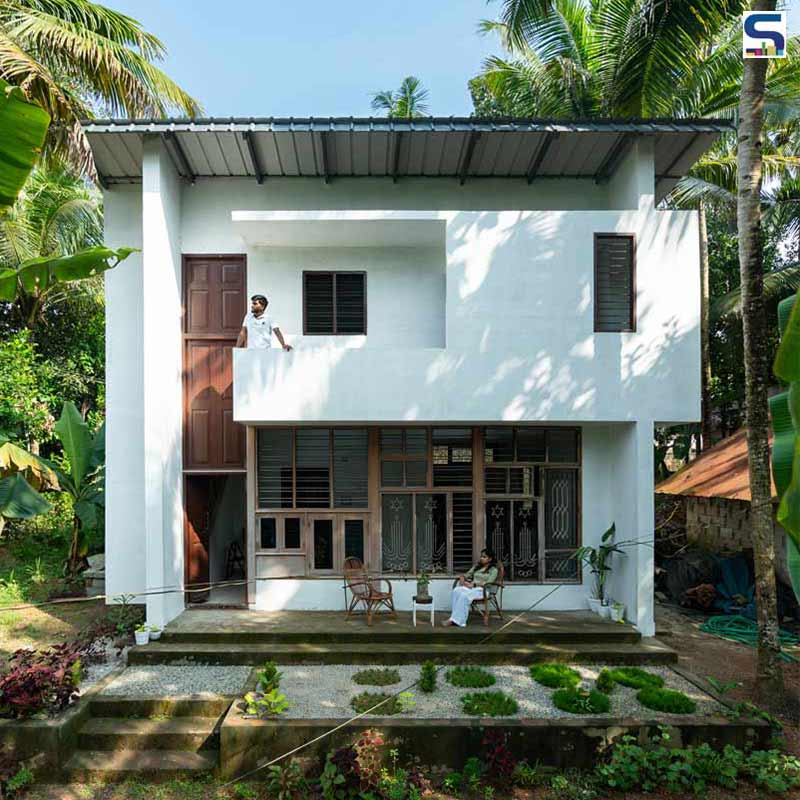
EGO Design Studio has crafted a low-budget home in Kerala that was left by an organization that promised to economically support it and was hence created by leftover materials and in-house labour. The project was designed for a family of four- a husband ( a carpenter) and a wife (who works as a house help) and their two small kids. The first thing while designing this project was to obtain materials at the cheapest possible rates. Bricks, windows and doors in the house are sourced free of cost from a demolition site. SURFACES REPORTER (SR) talked with the architect to gather more details about this beautiful abode made of discarded / donated building materials. Take a look:
Also Read: Is It Possible to Turn Discarded Plastic into Affordable Housing? | Julien De Smedt and Othalo Bring a Ground-breaking Solution
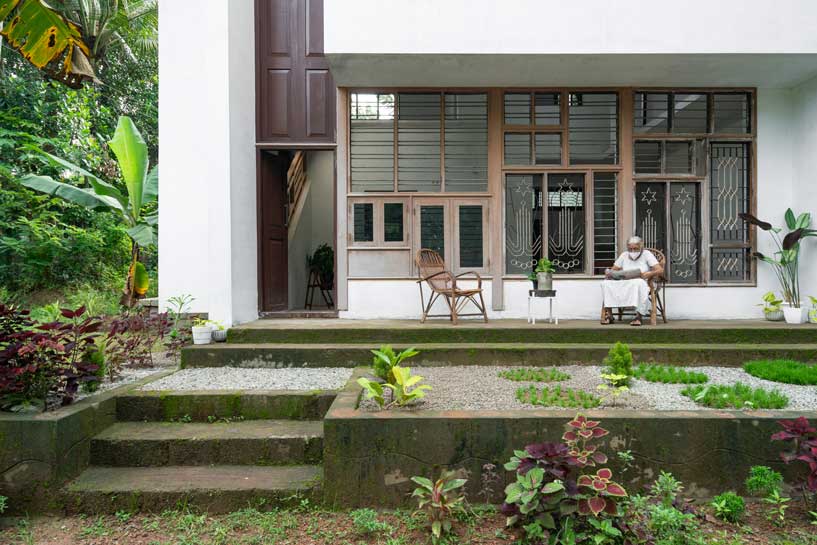 The project commenced as a low-income house economically supported by an organization on land the clients owned. The design was planned for a 1200 sqft two-floored residence. Once the foundation was completed the support group withdrew, and the clients barely had the finances to finish 500sqft. Now the task was to keep the leftover foundation and come up with a new design substantiating the need for a three-bedroom house.
The project commenced as a low-income house economically supported by an organization on land the clients owned. The design was planned for a 1200 sqft two-floored residence. Once the foundation was completed the support group withdrew, and the clients barely had the finances to finish 500sqft. Now the task was to keep the leftover foundation and come up with a new design substantiating the need for a three-bedroom house.
Sharing Across Projects
Ego Design Studio was working on the renovation of a high-budget house in Kowdiar, Trivandrum, Kerala when the project commenced, owing to the problems in the economy the office approached the client whose house was being demolished to support “a home leftover” by donating the wooden windows that were removed.
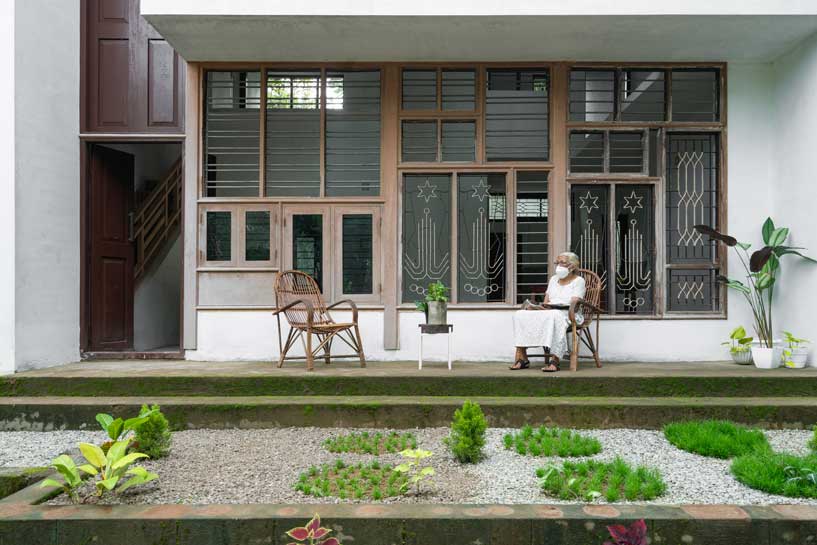 The client (Mr. Sugathan) was extremely generous and provided the windows free of cost. The project was started on this support and then mode material donations were tried.
The client (Mr. Sugathan) was extremely generous and provided the windows free of cost. The project was started on this support and then mode material donations were tried.
Financial Management: Material Donations: The house was built from leftover materials from construction sites and discarded materials sourced from building material industries by donors who were ready to support a low-income house.
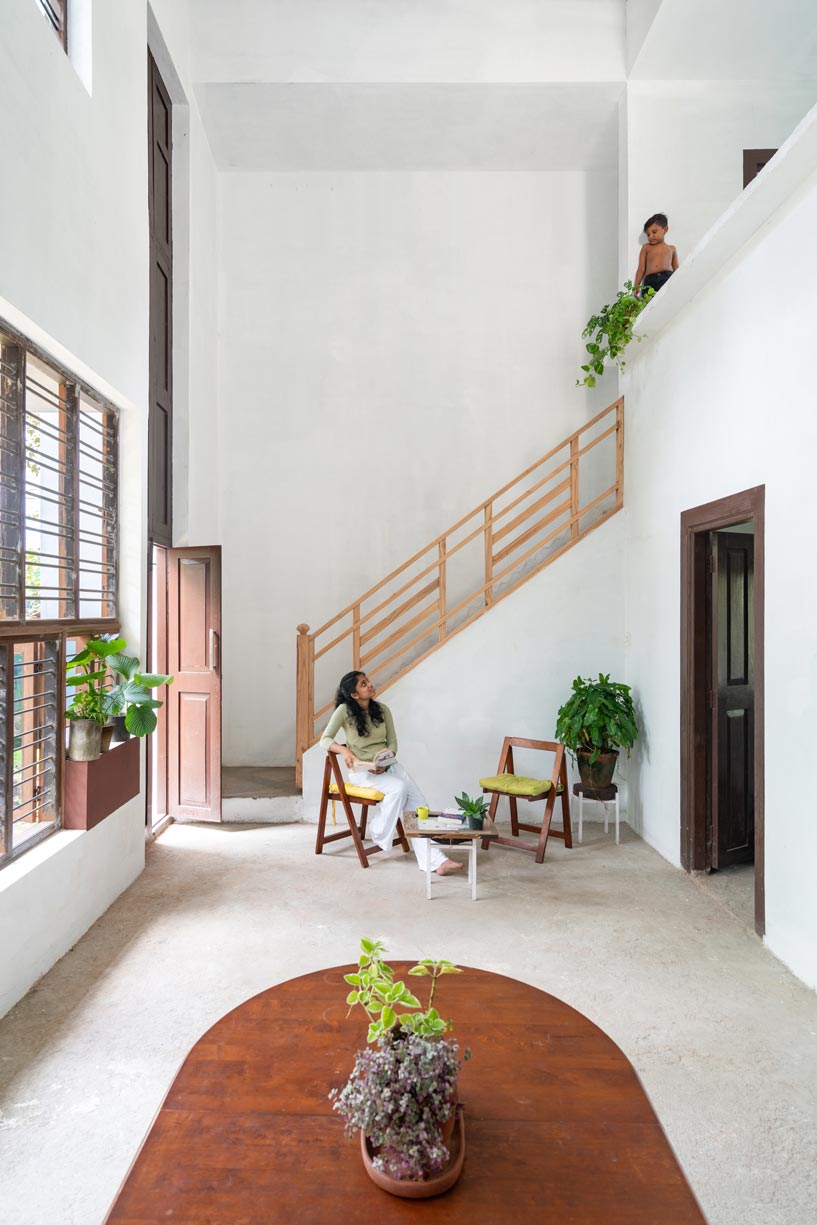 Minimal Plan: The plan was a basic square with almost no interior walls. keeping the material quantity to the bare minimum.
Minimal Plan: The plan was a basic square with almost no interior walls. keeping the material quantity to the bare minimum.
Walls: The first thing was to source the materials at the cheapest possible rates. The walls were done with interlocking mud blocks sourced from building material manufacturers (BUILD UP) nearby, who provided us with their bricks free of cost.
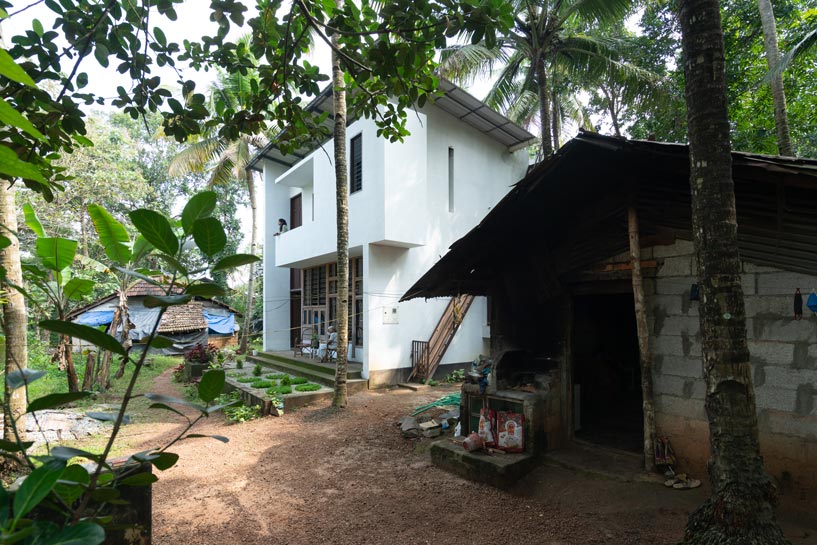 Openings: The windows and doors were sourced from a demolition site free of cost. The only thing left was the materials needed for concreting, and the steel for roofing and the labour. The area of concreting was limited to half the floor area and the remaining was covered by metal sheets.
Openings: The windows and doors were sourced from a demolition site free of cost. The only thing left was the materials needed for concreting, and the steel for roofing and the labour. The area of concreting was limited to half the floor area and the remaining was covered by metal sheets.
Labour: The client himself was a carpenter which took care of the woodworks needed, the remaining labour was procured by the support of his friends at base rates at times they were free or did not have work.
Now that the materials and labour were sorted out, the next question was “WHY SHOULD ALL LOW-INCOME HOUSES BE SMALL WINDOWLESS DARK CUBES?”
Also Read: Designer Uses Recycled Newspaper to Create Sturdy Bricks and Furniture | PaperBricks
Design Decisions
The Site Context and Present Home: The plain flat site was located away from the town and had no vehicular access, only a walkable road along its North side. The East face had lush green vegetation and paddy fields beyond it. Unlike all the other houses around, which faced the 4 feet walking track, “the home leftover” was designed facing this greenery (east) rather than the road.
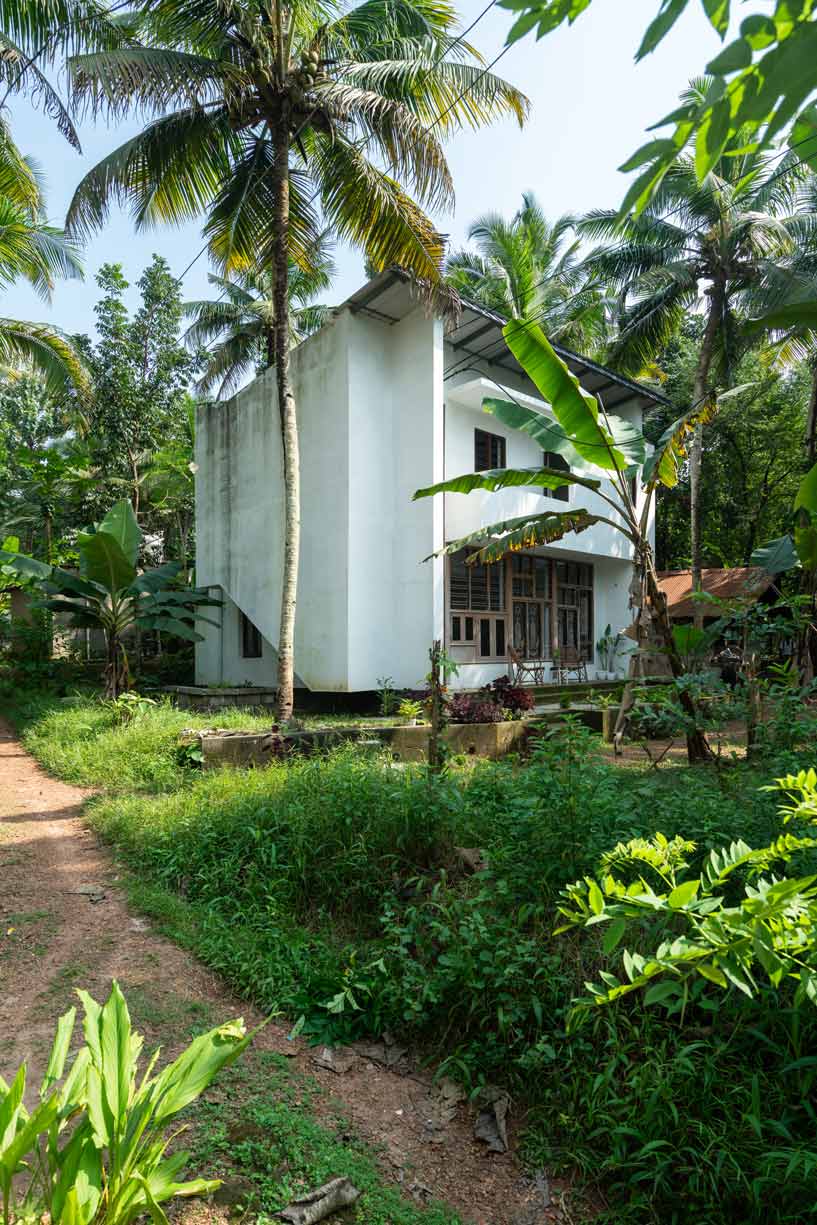 The site also had their old house which was a 15 ft x 15 ft shed with concrete block walls and a sheet roof. A dark single-room block without any windows to accommodate a family of four (parents/ two children). The only source of light inside is the entry door and a TV inside.
The site also had their old house which was a 15 ft x 15 ft shed with concrete block walls and a sheet roof. A dark single-room block without any windows to accommodate a family of four (parents/ two children). The only source of light inside is the entry door and a TV inside.
The Design:: The design was attempted in stark contrast to the space they already lived in. The dark room single storied space was converted into an all-white double height volume with ample openings. The front wall facing east was made into an all-window wall (a collage of windows collected from another renovation site ), facing the lush green exterior.
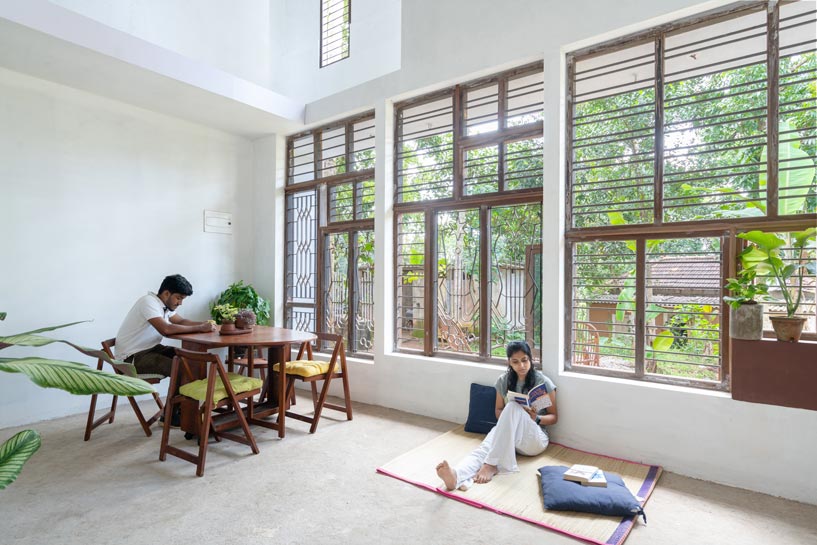 Massing: The building was designed as a single large cuboidal volume with minimum walls, with the bedroom and toilet as a solid block on the ground floor, and the daughters’ room as a solid block on the upper floor, with interior balconies overlooking the volume and exterior facing the greens The inner void volume, accommodates their need for religious gatherings and caters to their carpentry related activities in the monsoons.
Massing: The building was designed as a single large cuboidal volume with minimum walls, with the bedroom and toilet as a solid block on the ground floor, and the daughters’ room as a solid block on the upper floor, with interior balconies overlooking the volume and exterior facing the greens The inner void volume, accommodates their need for religious gatherings and caters to their carpentry related activities in the monsoons.
Also Read: Student Creates Pavement Made of Recycled Tyres that Self-Heals When it Rains | Rubber Pavement
A Home That Evolves
‘A home leftover’ was an attempt to create a shelter for a family who belonged to Low Income Group. The building was conceived as a skin that can be modified as and when the user needs, it and can also be expanded as they get financially stable. The architectural framework was given, the colour and interior details are all decisions of the client, executed as and when time and resources permit.
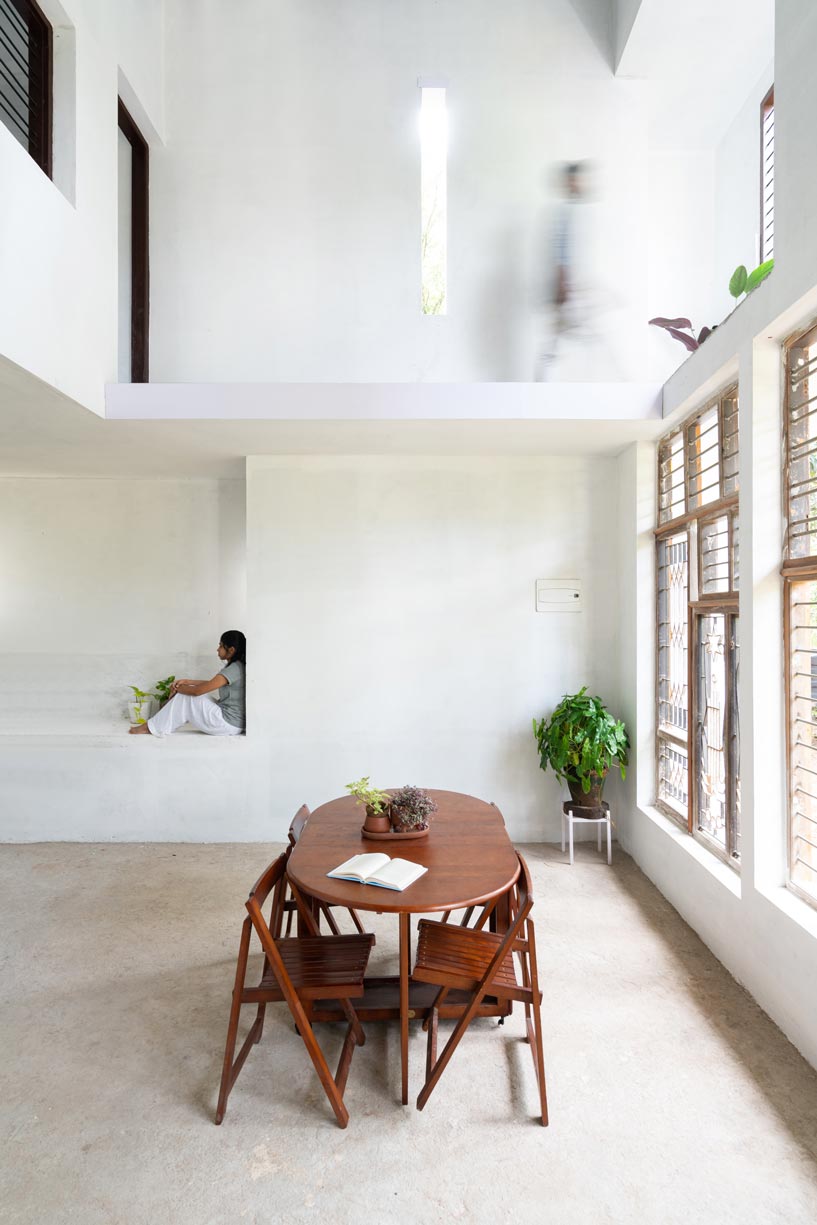 The involvement thereby helps them to feel ownership of the building.
The involvement thereby helps them to feel ownership of the building.
The project was an experiment on how every big budget project could fund a small budget project parallelly, at the same cost.
? It could be done by facilitating wasted materials of one site to be used in another project
? It could be done by arranging for about 10% more materials while purchasing for one project
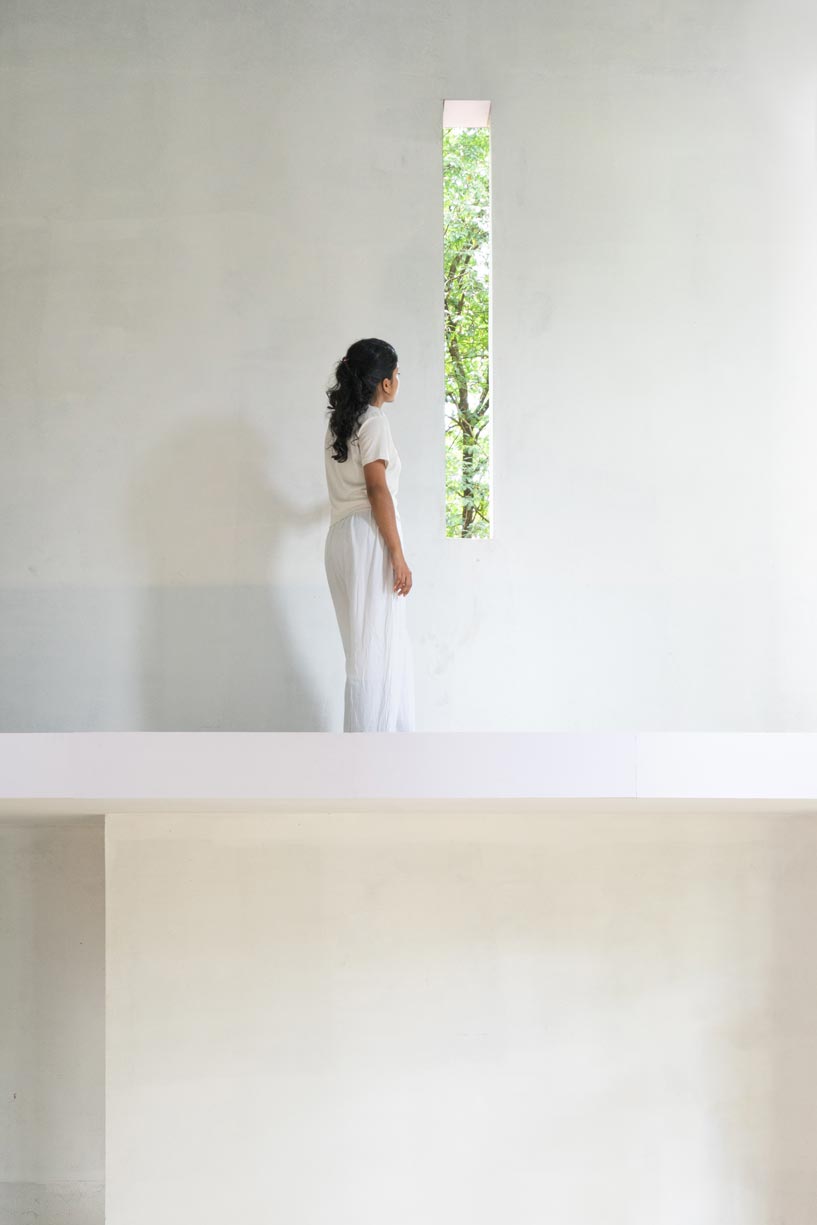 So when one big budget home is done, another family which cannot afford a house also gets home, so every house becomes two houses.
So when one big budget home is done, another family which cannot afford a house also gets home, so every house becomes two houses.
SURFACES REPORTER (SR) applauds and congratulates the design team at Ego Design Studio for creating such a beautiful abode out of sourced/ donated building materials. The project manifests that when human creativity meets dedication and will to create something exceptional, wonders happen.
Project Details
Project Name: A Home Leftover
Office Name: EGO DESIGN STUDIO
Office Website: www.egodesignstudio.com
Firm Location: Trivandrum, Kerala, India
Completion Year: November 2021
Gross Built Area (m2/ ft2): 1050sqft
Project Location: Chathannoor, Kollam , Kerala
Program / Use / Building Function: Single Family Residential Building
Lead Architects: Niranjan C Warrier
Photo Credits: Jishnu Vijay ( Out of Focus)
Other Details
Clients: A carpenter, his wife who works as a house help and two small kids | Area: 1050sqft.
Requirements: 3 bedspace, two toilets, living, dining, kitchen, a space for religious gathering.
Materiality : Second-grade interlocking mud blocks/ re-sourced windows and doors/ metal sheet and concrete roofing.
Labour : the owner is a carpenter who did the woodwork.
About The Firm
EGO design studio is a Kerala-based design practice founded in 2009 by a group of creative minds who shared commonalities in varied fields. The office started off as an architectural design consultancy and has now evolved into a socially relevant design practice involving cultural and community projects in and around Kerala. The creative partners of the design practice are Ar Niranjan C Warrier, Ar Abhilash UA, Ar Jayaram GS, Ar Aravind T, Ar Sudheesh S and Ar Jerry Sam Joseph. Their work interprets architecture as a manifestation of society in its basic form. The firm equally celebrates its flaws and positives. Every work aspires to be a mirror of its users and the context in which it exists. The studio doesn’t follow a particular design expression in idea or form. Each project is attempted as a new one in its own user and spatial context.
Keep reading SURFACES REPORTER for more such articles and stories.
Join us in SOCIAL MEDIA to stay updated
SR FACEBOOK | SR LINKEDIN | SR INSTAGRAM | SR YOUTUBE
Further, Subscribe to our magazine | Sign Up for the FREE Surfaces Reporter Magazine Newsletter
Also, check out Surfaces Reporter’s encouraging, exciting and educational WEBINARS here.
You may also like to read about:
Student Creates Generative Furniture from Wooden Leftovers | regrowth
Designer Reinvents Century-Old Jaipur Blue Pottery with Discarded Sanitary ware Waste | SR Exclusive
Discarded Pipes, Luminous Atrium and Sculpted Staircase Feature The Gleaming JackFruit Garden Residence in Kerala | Wallmakers
And more…